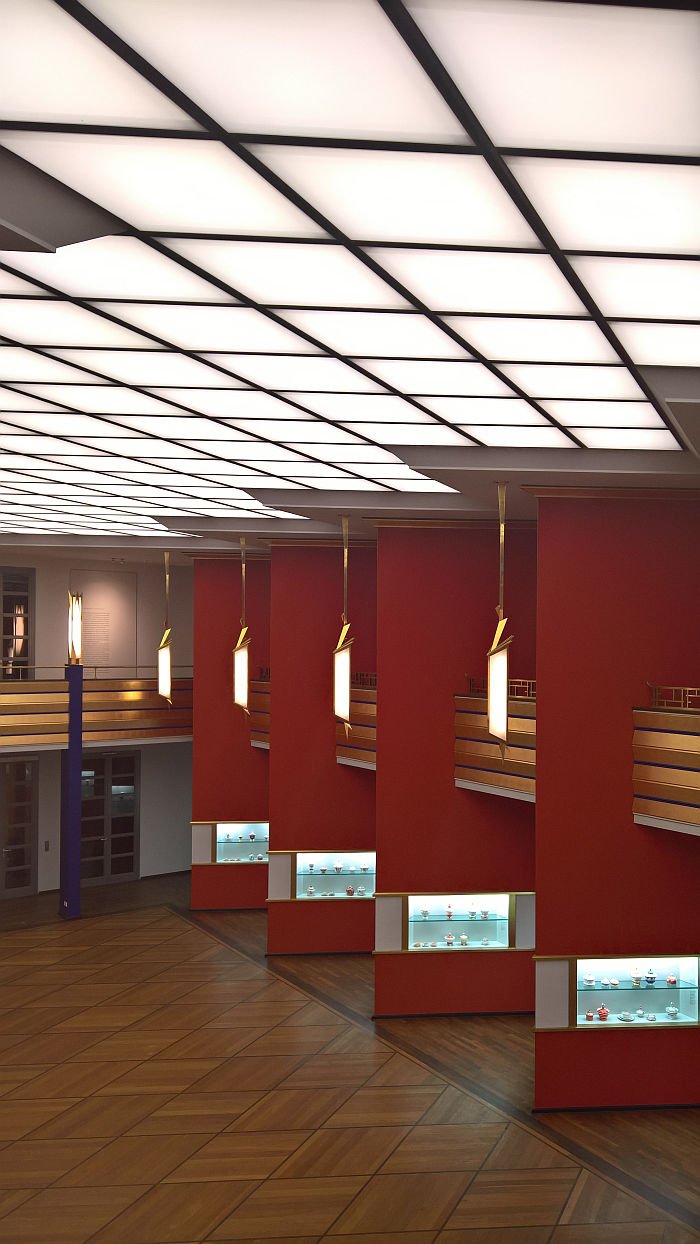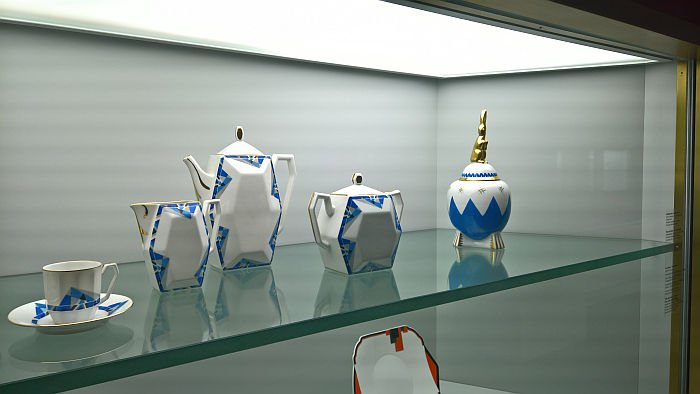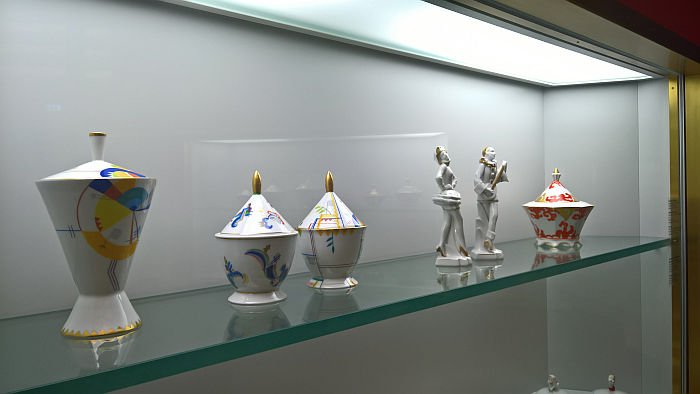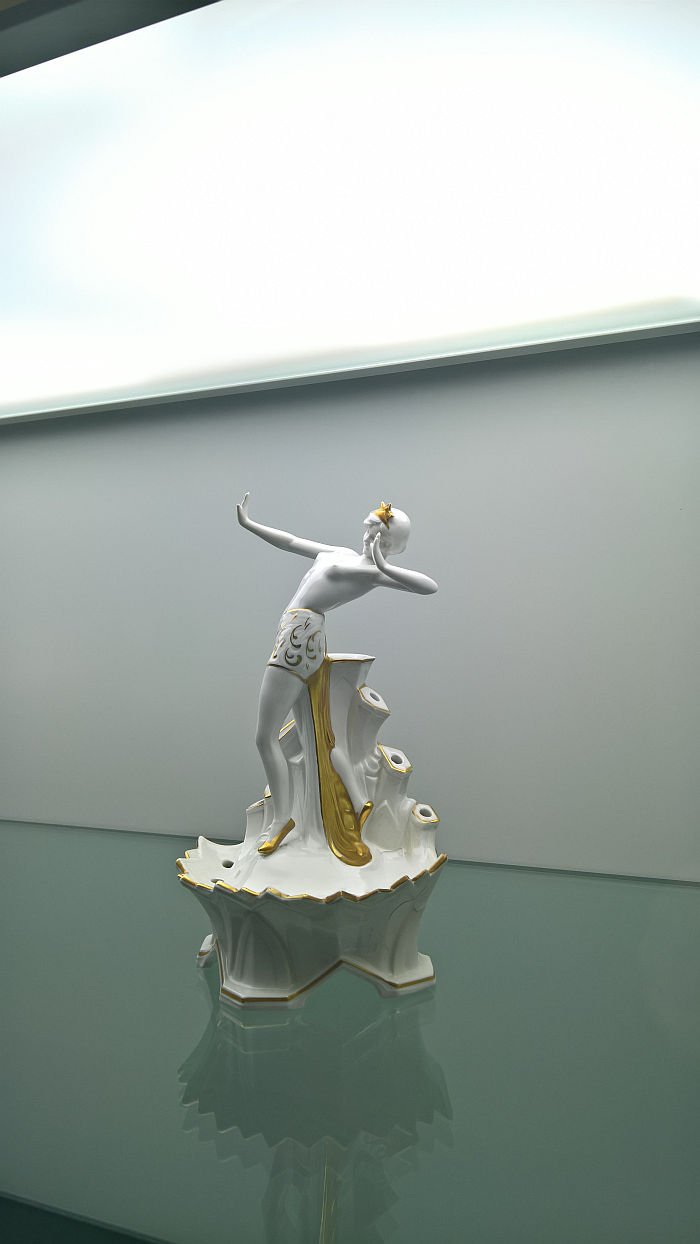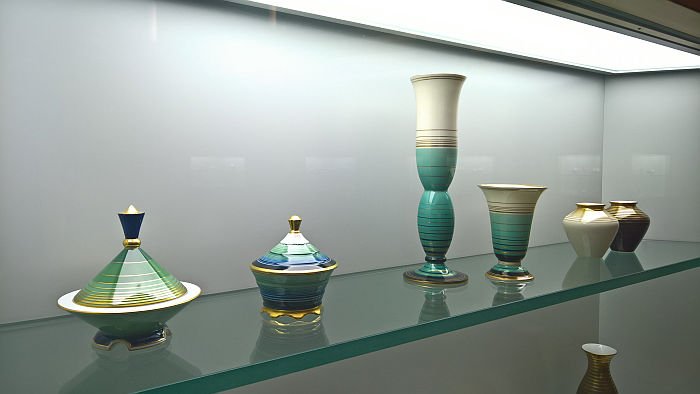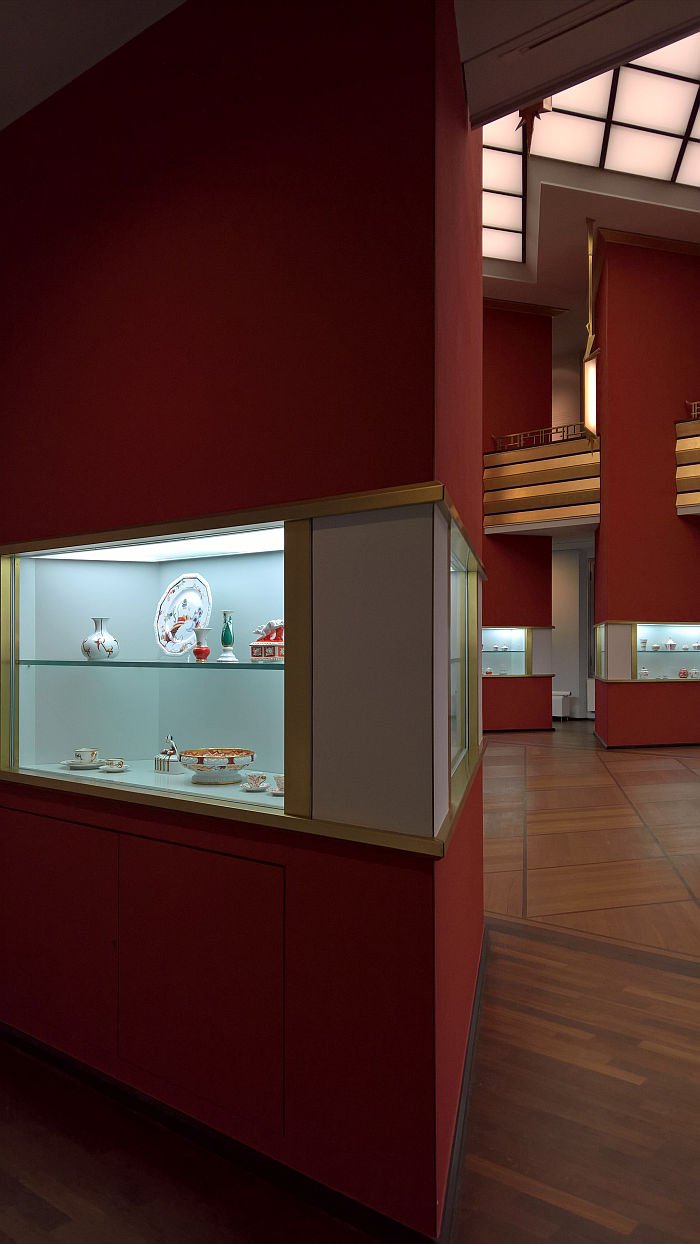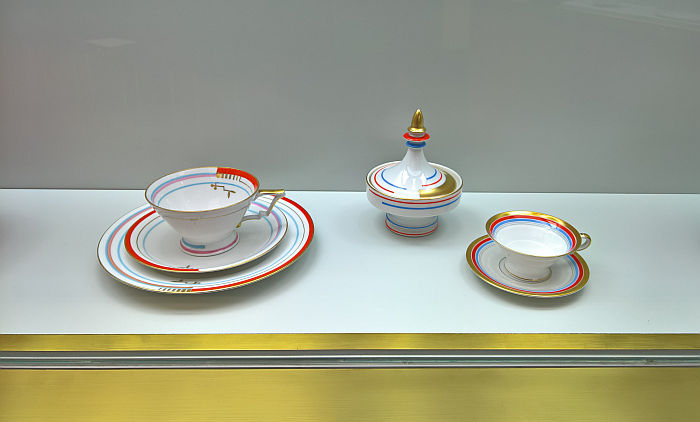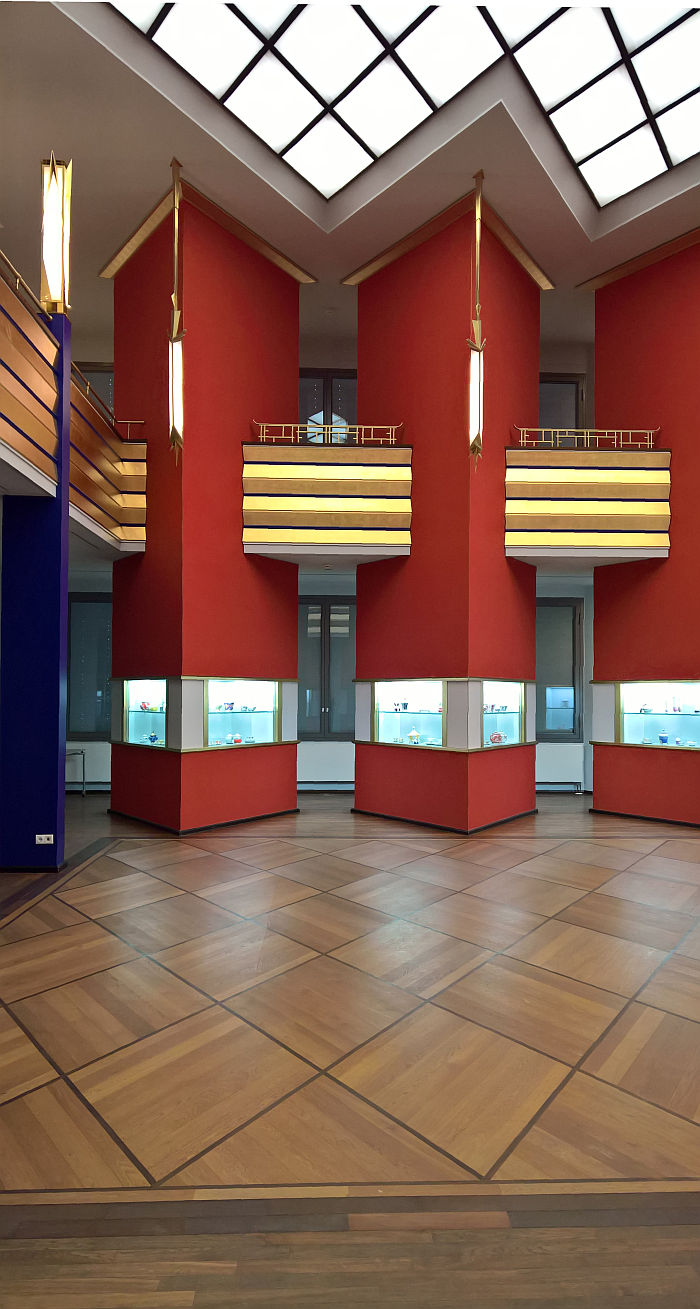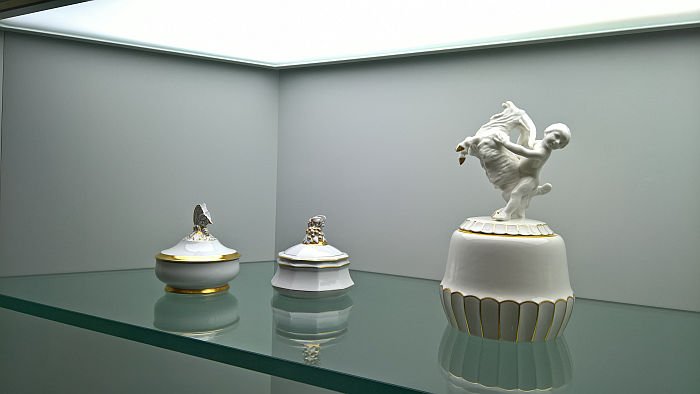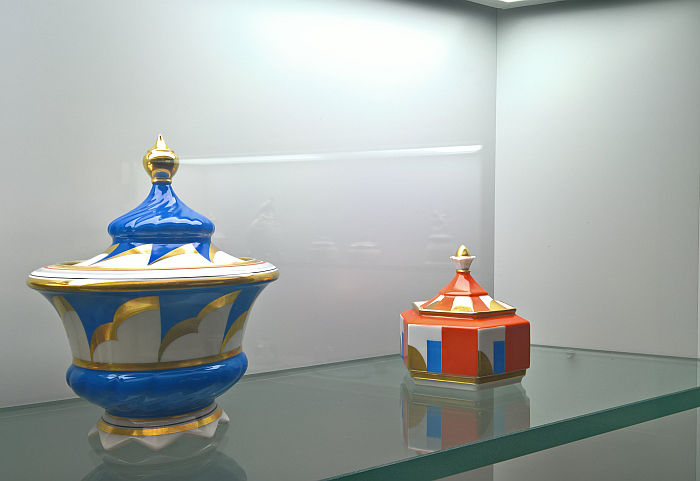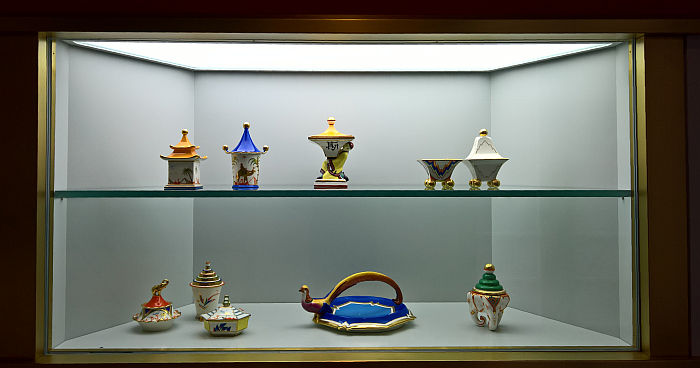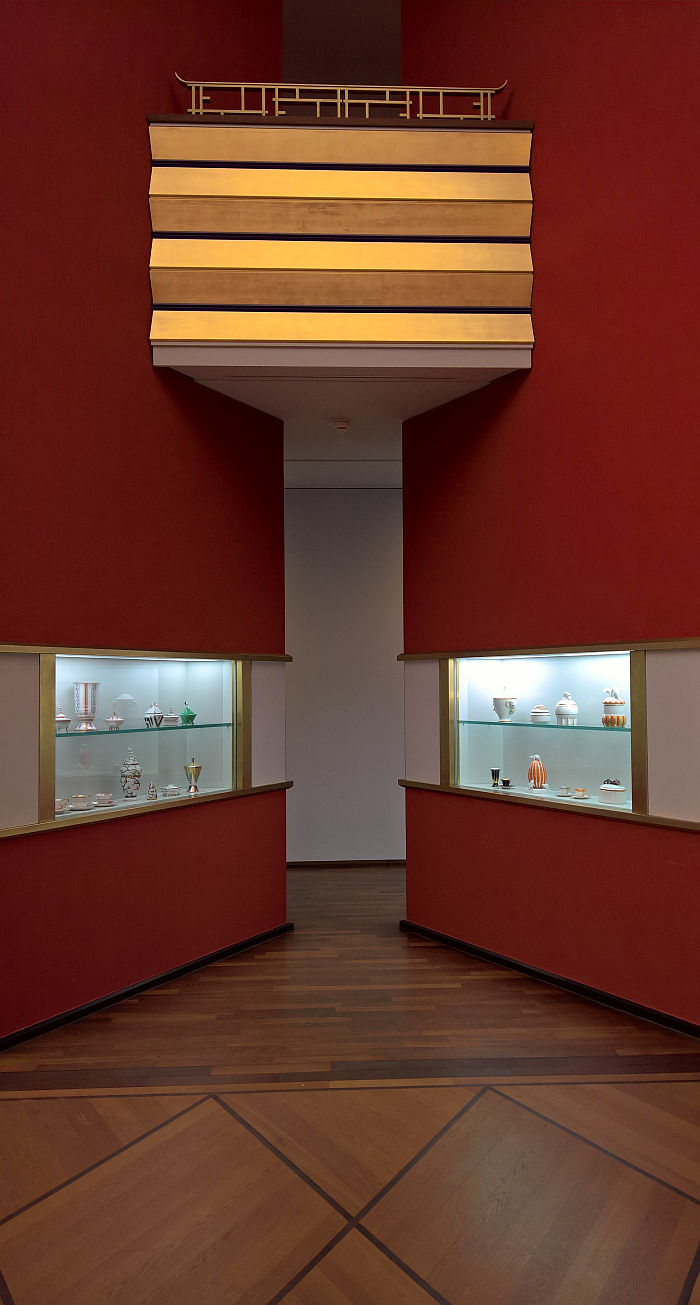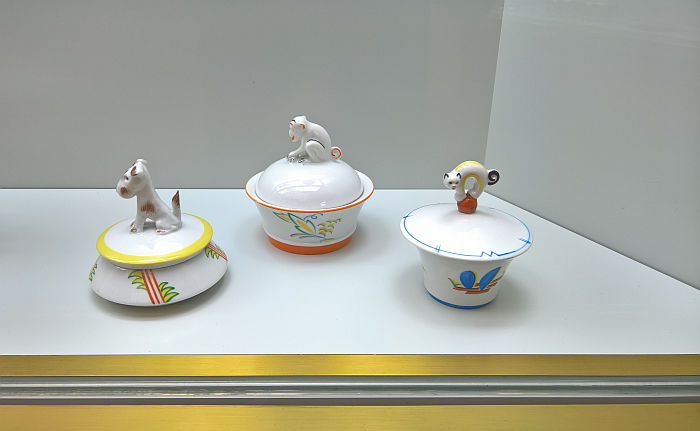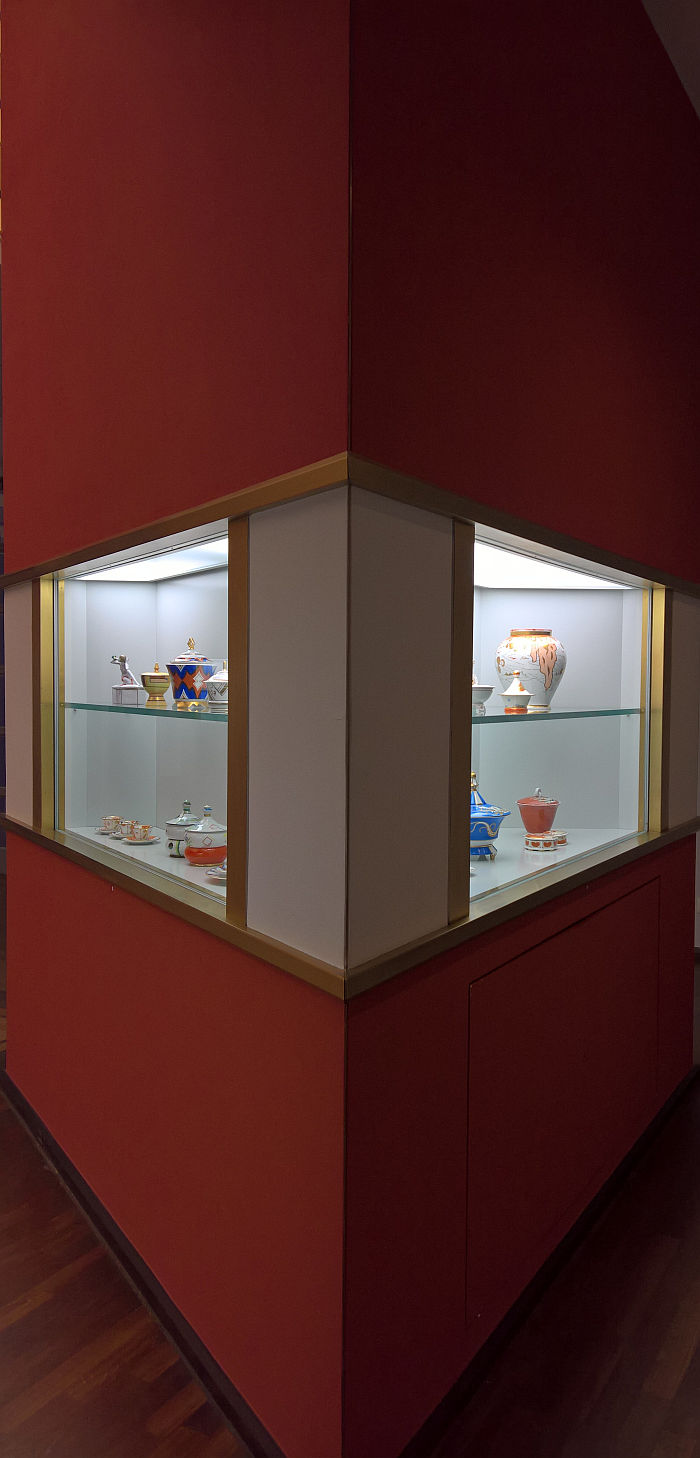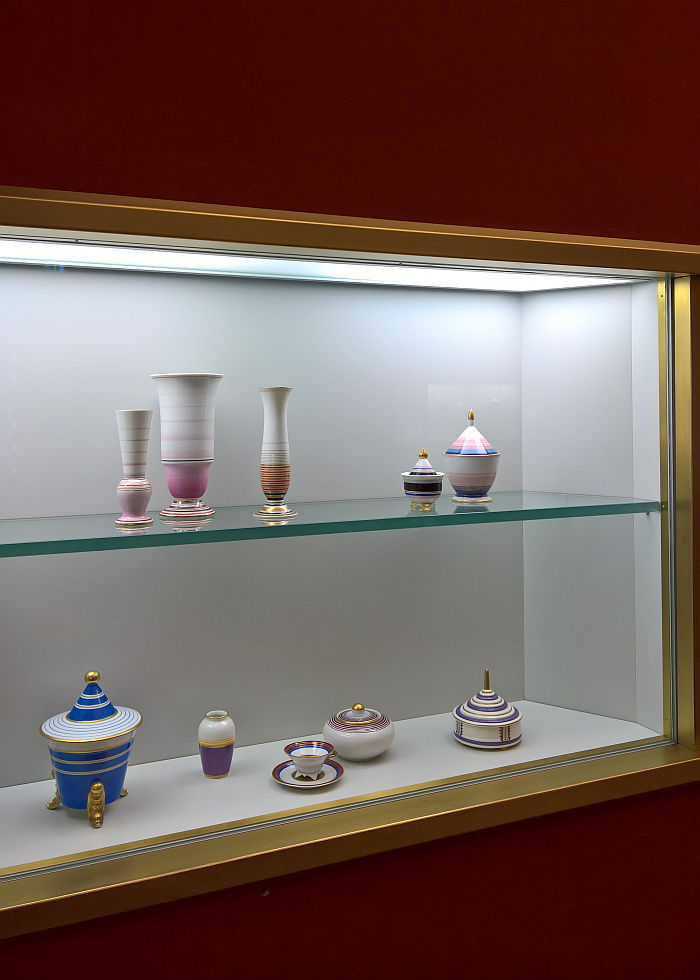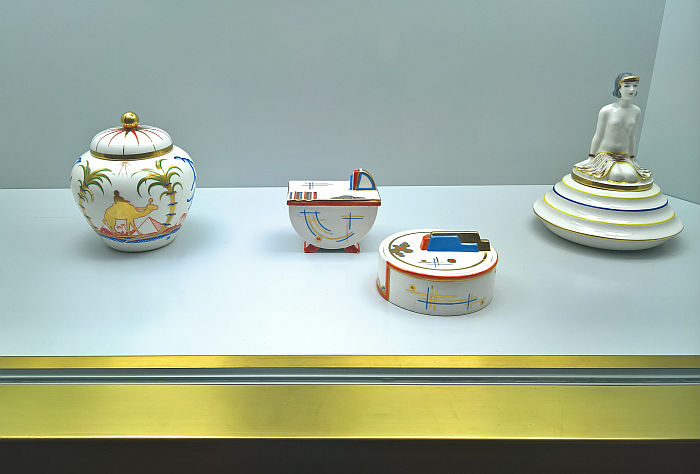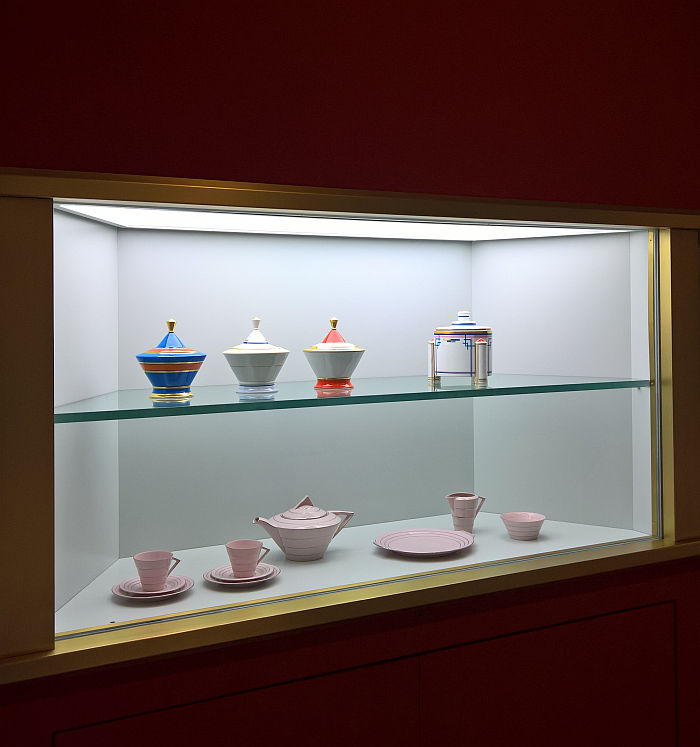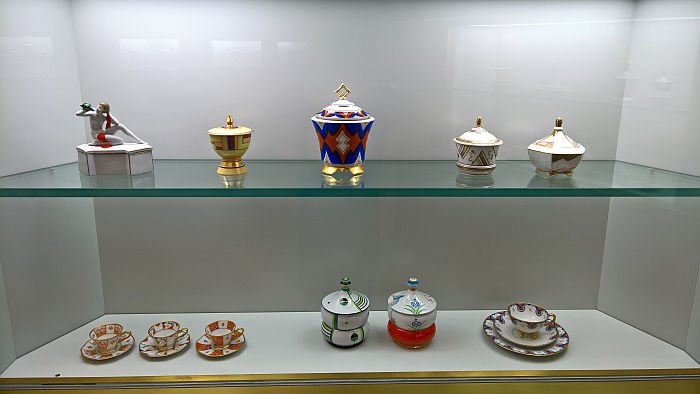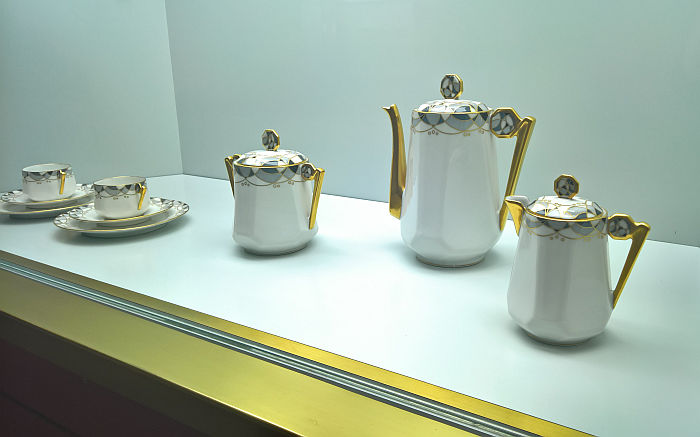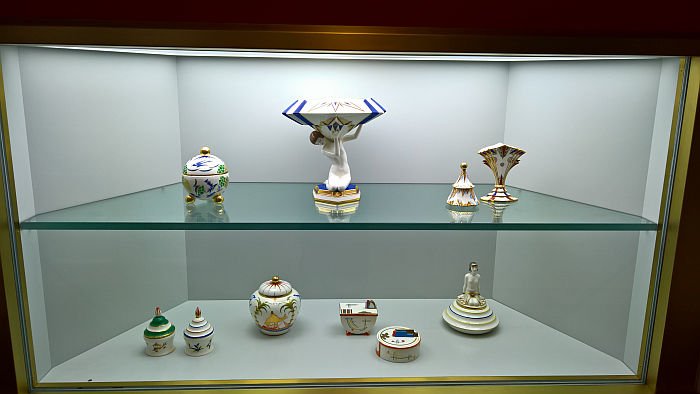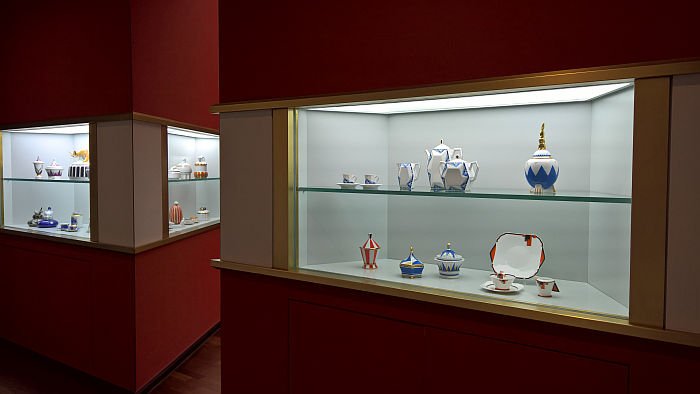On March 6th 1927 the exhibition Europäisches Kunstgewerbe opened at the Grassimuseum Leipzig, not only a presentation of contemporary European applied arts but the inaugural exhibition in the museum's (almost finished) new home on the city's Johannisplatz.
With the exhibition Spitzen des Art déco the Grassi Museum für Angewandte Kunst Leipzig stage not only a presentation of European Art déco porcelain, but a reminder of both the Johannisplatz complex's Art déco heritage and the vibrancy, colour and roar of the 1920s.
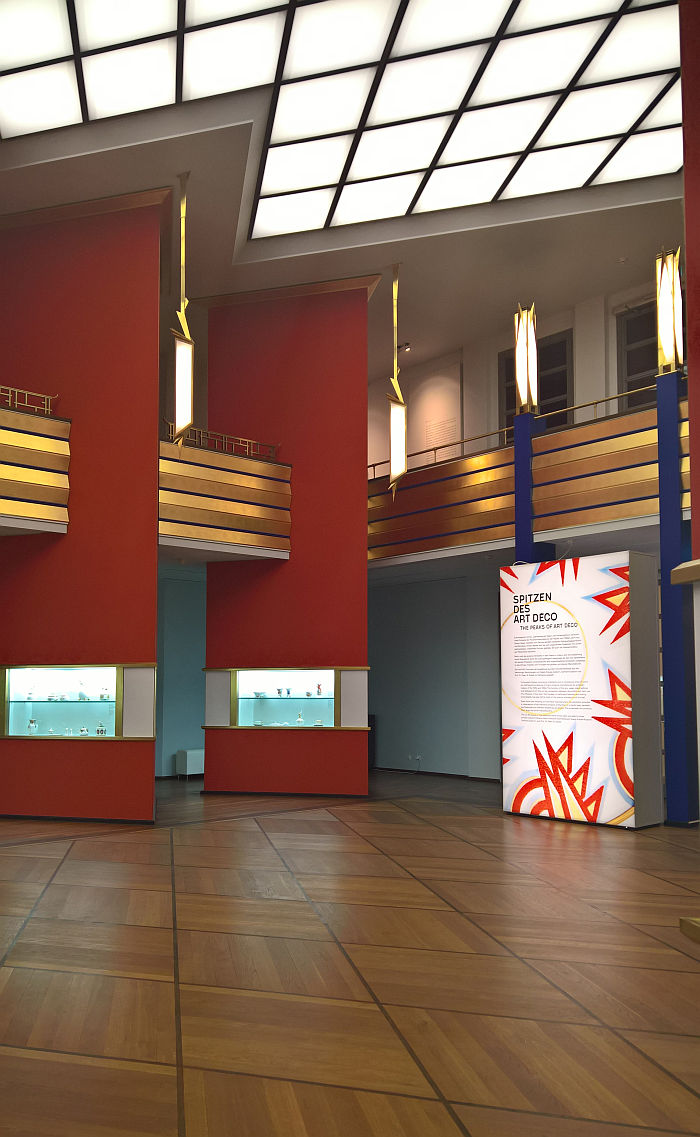
Approaching the Grassi museum complex from downtown Leipzig the most unequivocal, if almost singular, indication of an Art déco disposition is the Goldene Ananas, the Golden Pineapple, an 11m high zig-zag of gold copper which crowns Hans Voigt & Carl William Zweck's otherwise sober, rational, sachlich mid-1920s work.
A sober, rational, sachlich character continued inside and underscored by Josef (and Anni?) Albers 1926 stained glass window which rises in its geometric, monochrome, reduction with the equally restrained main staircase; the only divergence from the restraint of the interior being the zig-zag metal lamps which illuminate said staircase, lamps which quote the zig-zag of the Ananas high above them.
And a quotation raised to a maxim, and a maximum, in the so-called Pfeilerhalle: a space which greeted visitors at its 1927 opening with a cacophony of colour, light and zig-zags, a space hewn very much as a physical embodiment of that roar of the 1920s as European society got itself back on its feet following the horrors and privations of the Great War, that war to end all wars. A roar of hope in the bright new future that awaited Europe.......
And a cacophony of colour, light and zig-zags which has lost none of its potency, and which today in addition to being a celebration of the tumult, the clamour, of Art déco stands as a reminder that alongside the sober Sachlichkeit of the 1920s as so popularly exemplified by the white cubes and bent tubular steel of the Modernist Functionalists, other artistic and design currents were flowing through society, not least Surrealism and Art déco.
Considerations, and a space, complimented and extended by the objects on show in Spitzen des Art déco
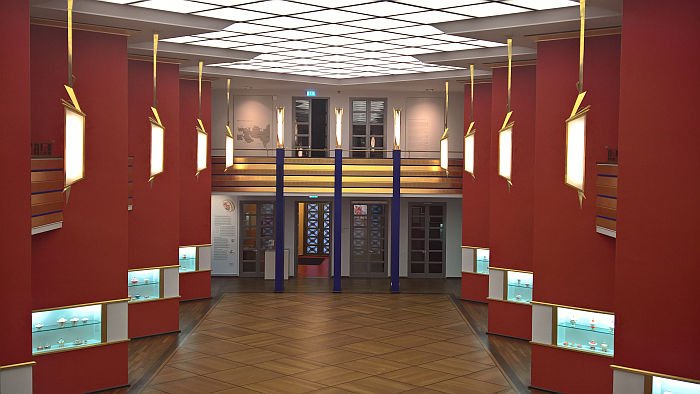
Presenting some 500 objects from 50+ European manufacturers and loaned for the occasion from 3 Hamburg collectors, Spitzen des Art déco is both a succinct introduction to the porcelain of early 20th century Europe, and an invitation to reflect on that porcelain in context of the wider realities of early 20th century Europe.
An introduction and invitation narrated and elucidated on the one hand by the variety of differing object types on show, including, for example, mokka cups, storage jars of numerous genres, serving plates or vases, including a few whose self-confident naked female forms remind us that the 1920s were the beginnings of a more sexually, and gender, open and liberated society; and an introduction and invitation narrated and elucidated on the other hand through the variety of approaches to and understandings of decoration on show.
Limits of space and time forbid and forebode an exhaustive discussion on the myriad decorative variations and positions on show in Spitzen des Art déco; however, roughly, and accepting the inaccuracy in our roughness, the displayed objects can be considered in three broad groups, three groups which help one approach a better understanding of the (at times contrasting) spirit(s) of the age: firstly those that utilise what we're referring to as folkloric images, be that those reflective of the fantasy of fairytale, the symbolism of the animal kingdom or the exotic, foreign, of non-European cultures, for all the Chinese, the Indian or the Arabic, and less the Japanese that so inspired and informed the Art Nouveauists; secondly objects that are much more abstract in their expression including objects such as three jars from Rosenthal whose decoration could be confused for a geometry free colour theory exercise, or by the objects of the Maria collection, similarly from Rosenthal, and which depict a pheasant freed from space but still held in time; and thirdly, very rational, reserved, geometric, works which employ colour as much as a functional as a decorative element, or which on occasion more or less ignore any pretence at decoration, and which in doing so point towards the more Modernist Functionalist understandings of the 1920s. While remaining very much fundamentally opposed to white cubes and steel tubing.
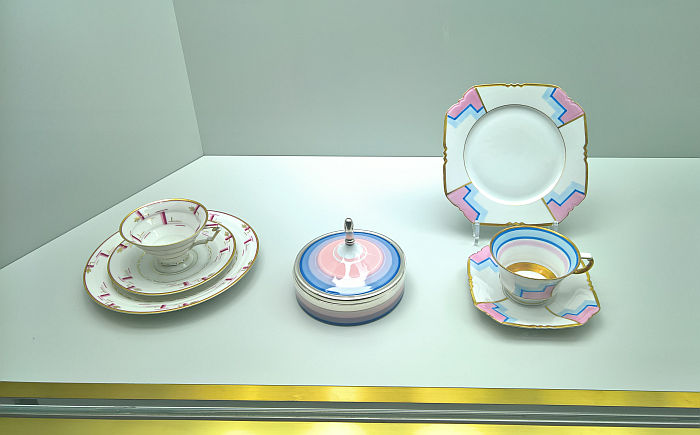
And whereas the objects are supported by short, bi-lingual German/English, descriptions of some of the most widely represented manufacturers, including Fraureuther Porzellanfabrik, Lorenz Hutschenreuther or Jaeger & Co, and also short discussions on Art déco and the context in which the displayed objects arose, as a showcase Spitzen des Art déco is less one that explains and explores as one that presents, is very much a showcase in which the visitor is left to make their own discoveries and considerations. Which isn't a complaint. Far from it.
For our part our attention was particularly taken, and amongst many, many other works, by two boxes with an angel as decoration, one by Germany's C & E Carstens and originating in the early 1920s, and one by from ca 1930 by Sweden's Karlskrona Porslinsfabrik, and which in their similarity tend to imply that the Swedish model was, let's say, inspired, by the German model, or perhaps better put, tends to confirm that early 20th century Swedish design was greatly influenced by early 20th century German design, which is always worth remembering; by a coffee service from Chabrol Frères et Poirier, Limoges, that won a 1st prize at the 1925 Paris Exposition internationale des Arts décoratifs et industriels modernes, that exhibition which so unequivocally juxtaposed more traditional understandings of architecture and design with the international avant-garde understandings, and a service which in its idiosyncratic understanding of geometry helps, and alongside numerous other examples, explain that in the 1920s form wasn't always diligently following function, often it went its own way. In addition we spent a lot of time considering the various objects by Gotha based Ilse Pfeffer from the late 1920s, and thus works created, more or less, around the same time Marianne Brandt was in charge of design at Ruppelwerk Gotha, and which indicate, imply, for all when considered in context of the works Ilse Pfeffer was realising just a few decades earlier, that a further chapter should (arguably) have been included in Inspired by Bauhaus – Gotha Experiences Modernity at the KunstForum Gotha. Albeit accepting that such would have involved adding a fourth storey to the KunstForum Gotha. And deleting the first part of the exhibition title.
Then there is/was an anonymous pink tea service with silver detail from ca. 1930, interesting on the one hand for its audacious pinkness, on the other hand for its more or less complete lack of decoration, and on the all important third hand for being through-dyed. The vast, vast, majority of the works on show in Spitzen des Art déco being hand-painted.
And thus a tea service which very neatly highlights a fundamental difference between the late 1920s/early 1930s works on show in Spitzen des Art déco and those late 1920s/early 1930s works on show in Decoration as Trespass? at the Werkbundarchiv – Museum der Dinge Berlin with their spray painted decoration, their industrial application of colours, patterns and abstractions. And the equally fundamental difference that whereas what is on show in Berlin is (largely) stoneware, in Leipzig it is porcelain.
Two small but important differences, not least in context of the final price of the objects, but for all two differences which represent very different aspects of early 20th century object design, very different understandings of object design in the early 20th century, very different positions to object design in the early 20th century, and differences which encapsulate many of the discussions and debates of the early 20th century, not least the one between proponents of craft and proponents of industrial production.
Discussions and debates which although not in the foreground in Spitzen des Art déco are very much there, are very much embodied in the processes by which the exhibited objects arose, are inherent in the objects understandings of the world in which they existed, their understandings of the shape and the volume of contemporary, and future, society. And discussions and debates elegantly reflected in the dialogue between the objects and the context in which they are being presented; the objects standing not only in relation to the Pfeilerhalle, but to the dialogue between the Pfeilerhalle and its neighbouring spaces, and thus in relation to the discussions and debates of the early 20th century, not least the one between proponents of ornamentation and proponents of the unadulterated form.
And thus as a very simple reminder that fundamental discussions and debates, discussions and debates on form, ornamentation, materials, production, functionality, et al were taking place in the early 20th century. And continue to do so. Discussions and debates advanced and informed today by the discussions and debates of then.
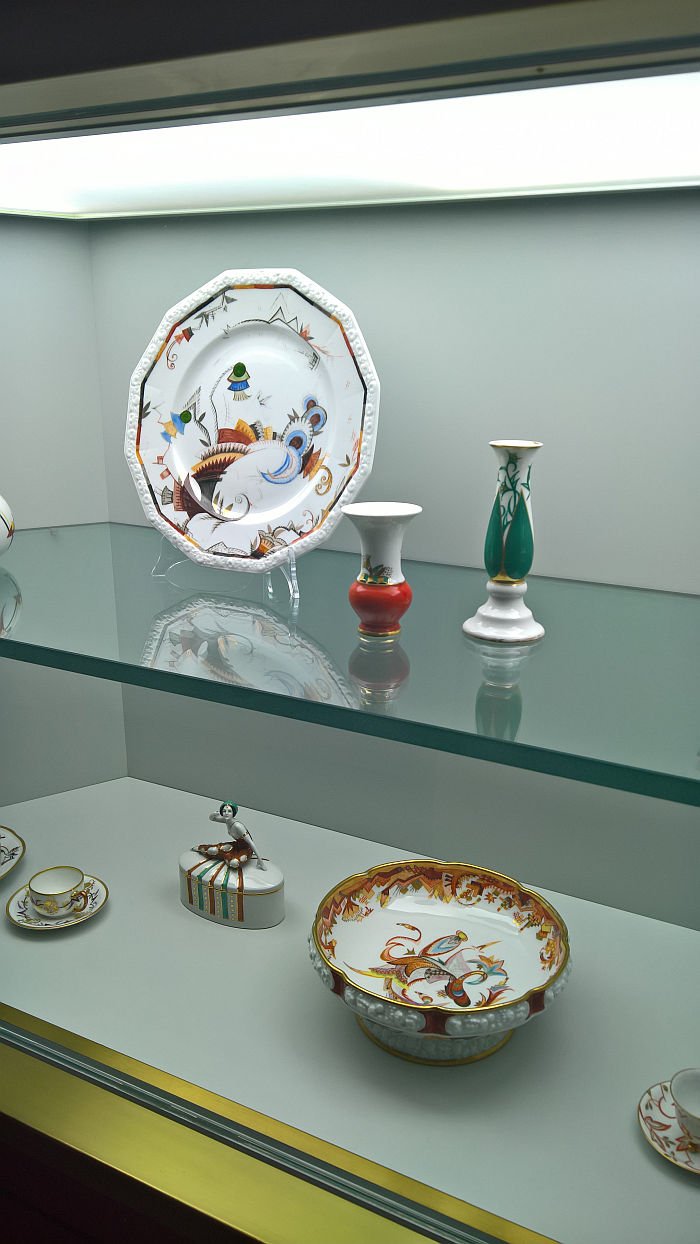
Not, as we say, that such discussions and debates are in the foreground in Spitzen des Art déco. That would require a different exhibition, one that sets ceramic objects of differing positions directly opposite one-another, one that forces a dialogue between ceramic objects of differing positions. Spitzen des Art déco is very much about porcelain objects of very similar positions, if differing expressions of those positions, is a showcases about the similarities between the objects, the differences between the objects, the parallels between what differing manufacturers were realising, the understandings, emotions and attitudes, one can glean from those similarities, differences, parallels, motifs, forms, colours et al. And is a very much a presentation of small objects in glass vitrines.
And as such not a good presentation concept....?
Au contraire........!
Although small objects in glass vitrines is rarely a good presentation concept, it is one that is often unavoidable, and one which in context of Spitzen des Art déco is more than fitting: whereas the Brandenburgisches Landesmuseum für moderne Kunst in Cottbus constructed very satisfying faux pottery shops as a platform to present 1920s pottery, in Leipzig they built an an equally satisfying exhibition hall which reflects the spirit and elan in which the works arose. Built it some 90 years before the opening of Spitzen des Art déco but, one could argue, in preparation for it.
In preparation for a showcase which presents porcelain in vitrines of the same era, vitrines conceived in the same understandings of evolving realities, and vitrines and porcelain which in their accord with one another, and in their melodic, rhythmic and harmonic contrast to all that outwith the Pfeilerhalle provides, for a succinct introduction to one expression of early 20th ceramics. And which in doing so helps underscore that Art déco was but one expression of the early 20th century, a roar of colour and vibrancy against the rational, restrained, Sachlichkeit, of the Functionalists, and a positive, affirming, roar of hope in the bright new future that awaited Europe.......
Spitzen des Art déco runs at the Grassi Museum für Angewandte Kunst Leipzig, Johannisplatz 5-11, 04103 Leipzig until Sunday October 11th
Full details can be found at www.grassimak.de/spitzen-des-art-deco
